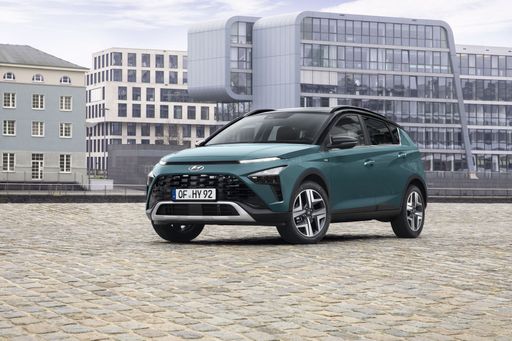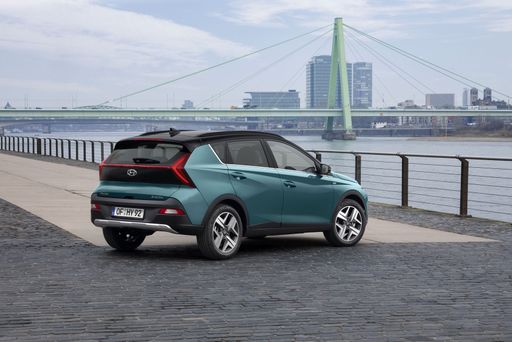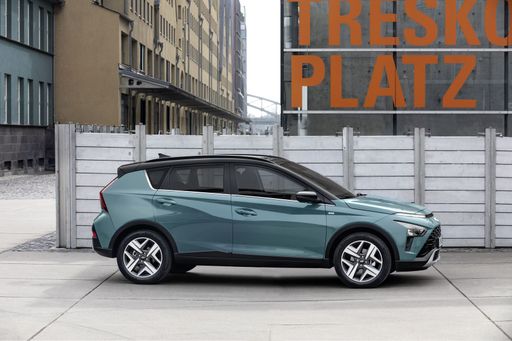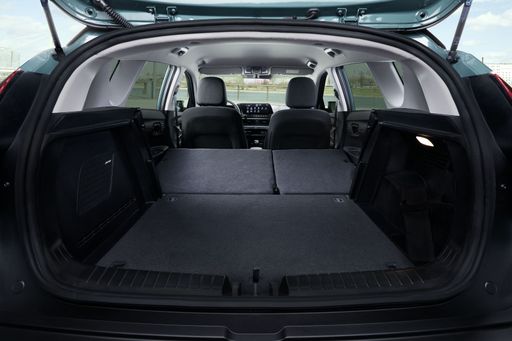Hyundai Bayon vs Mazda 3 Sedan – Differences & prices compared
Compare performance, boot space, consumption and price in one view.
Find out now: which car is the better choice for you – Hyundai Bayon or Mazda 3 Sedan?
The Hyundai Bayon (SUV) comes with a Petrol engine and Manuel or Automatic transmission. In comparison, the Mazda 3 Sedan (Sedan) features a Petrol MHEV engine with Manuel or Automatic transmission.
When it comes to boot capacity, the Hyundai Bayon offers 411 L, while the Mazda 3 Sedan provides 450 L – depending on how much space you need. If you’re looking for more power, decide whether the 100 HP of the Hyundai Bayon or the 186 HP of the Mazda 3 Sedan suits your needs better.
In terms of consumption, the values are 5.40 L per 100 km for the Hyundai Bayon, and 5.50 L for the Mazda 3 Sedan.
Price-wise, the Hyundai Bayon starts at 20100 £, while the Mazda 3 Sedan is available from 25000 £. Compare all the details and find out which model fits your lifestyle best!
Hyundai Bayon
The Hyundai Bayon is a compact crossover that effortlessly merges practicality with modern design. Its sleek exterior and spacious interior make it an ideal choice for urban settings and longer journeys alike. With a focus on comfort and connectivity, this vehicle provides a smooth driving experience paired with advanced technology features.
details @ hyundai.news
@ hyundai.news
 @ hyundai.news
@ hyundai.news
 @ hyundai.news
@ hyundai.news
 @ hyundai.news
@ hyundai.news
 @ hyundai.news
@ hyundai.news
Mazda 3 Sedan
The Mazda 3 Sedan stands out with its elegant and sleek design, capturing attention on the road with its refined aesthetics. Inside, it offers a well-crafted and comfortable cabin, providing a pleasurable driving experience marked by quality materials and advanced features. The car's performance is reliable and smooth, making it a versatile choice for both city driving and long-distance journeys.
details

|
|
|
|
|
Costs and Consumption |
|
|---|---|
|
Price
20100 - 25800 £
|
Price
25000 - 34200 £
|
|
Consumption L/100km
5.4 - 5.5 L
|
Consumption L/100km
5.5 - 6.1 L
|
|
Consumption kWh/100km
-
|
Consumption kWh/100km
-
|
|
Electric Range
-
|
Electric Range
-
|
|
Battery Capacity
-
|
Battery Capacity
-
|
|
co2
124 g/km
|
co2
123 - 135 g/km
|
|
Fuel tank capacity
40 L
|
Fuel tank capacity
51 L
|
Dimensions and Body |
|
|---|---|
|
Body Type
SUV
|
Body Type
Sedan
|
|
Seats
5
|
Seats
5
|
|
Doors
5
|
Doors
4
|
|
Curb weight
1170 - 1195 kg
|
Curb weight
1420 - 1492 kg
|
|
Trunk capacity
411 L
|
Trunk capacity
450 L
|
|
Length
4180 mm
|
Length
4660 mm
|
|
Width
1775 mm
|
Width
1795 mm
|
|
Height
1500 mm
|
Height
1440 mm
|
|
Payload
460 - 465 kg
|
Payload
467 - 481 kg
|
Engine and Performance |
|
|---|---|
|
Engine Type
Petrol
|
Engine Type
Petrol MHEV
|
|
Transmission
Manuel, Automatic
|
Transmission
Manuel, Automatic
|
|
Transmission Detail
Manual Gearbox, Dual-Clutch Automatic
|
Transmission Detail
Manual Gearbox, Automatic Gearbox
|
|
Drive Type
Front-Wheel Drive
|
Drive Type
Front-Wheel Drive
|
|
Power HP
100 HP
|
Power HP
140 - 186 HP
|
|
Acceleration 0-100km/h
11.3 - 12.4 s
|
Acceleration 0-100km/h
8.1 - 9.8 s
|
|
Max Speed
176 - 179 km/h
|
Max Speed
203 - 216 km/h
|
|
Torque
172 - 200 Nm
|
Torque
238 - 240 Nm
|
|
Number of Cylinders
3
|
Number of Cylinders
4
|
|
Power kW
74 kW
|
Power kW
103 - 137 kW
|
|
Engine capacity
998 cm3
|
Engine capacity
1998 - 2488 cm3
|
General |
|
|---|---|
|
Model Year
2024
|
Model Year
2025
|
|
CO2 Efficiency Class
D
|
CO2 Efficiency Class
D
|
|
Brand
Hyundai
|
Brand
Mazda
|
Hyundai Bayon
Introducing the Hyundai Bayon: A New Era in Compact SUVs
The Hyundai Bayon, a compact SUV designed with urban adventurers in mind, is making waves with its exceptional blend of style, performance, and technology. The brand has pulled out all the stops to ensure that the Bayon stands out in the crowded SUV market, offering a vehicle that is both practical and innovative.
Sleek Design and Cutting-Edge Aerodynamics
The Bayon features a striking exterior design, characterised by its bold lines and angular shapes. With a length of 4180 mm, a width of 1775 mm, and a height of 1500 mm, the Bayon commands attention with its modern appeal and aerodynamic efficiency. These dimensions not only contribute to its sleek design but also enhance fuel efficiency, achieving an impressive 5.4 L/100 km.
Engine Performance and Specifications
Under the bonnet, the Bayon is powered by a 1.0-litre T-GDI petrol engine, delivering a robust 100 PS or 74 kW. This engine is available with either a manual or automatic gearbox, meeting varied driver preferences. The front-wheel-drive system complements its urban-centric design, ensuring a smooth and responsive ride.
Maximised Interior Space and Comfort
The spacious interior of the Bayon accommodates up to five passengers comfortably. The vehicle boasts a boot space of 411 litres, perfect for both everyday use and weekend getaways. The cabin is designed with practicality and technology in mind, with intuitive controls and ample storage options.
Advanced Technology and Connectivity
Hyundai has equipped the Bayon with state-of-the-art technology to enhance the driving experience. The SUV features a high-resolution touchscreen, offering seamless connectivity with Apple CarPlay and Android Auto. Safety is also a priority, with multiple driver assistance systems including lane-keeping assist and forward collision avoidance assist.
Environmental Efficiency
Despite its powerful performance, the Bayon achieves a respectable CO2 efficiency class of D, with emissions as low as 122 g/km. This balance between performance and environmental responsibility makes the Bayon an attractive option for conscientious drivers.
Affordability and Market Appeal
The Hyundai Bayon is competitively priced, ranging from €22,900 to €29,600. Its affordable running costs, estimated at 32.3 to 36.4 cents per kilometre, further enhance its appeal to budget-conscious consumers. With monthly costs ranging from €806 to €909, the Bayon provides excellent value without compromising on features or performance.
Final Thoughts
The Hyundai Bayon truly stands out in the compact SUV segment, combining style, innovation, and practicality in an appealing package. It offers a versatile driving experience suited to the demands of modern urban living, making it a top contender in its class. As Hyundai continues to champion forward-thinking design and technology, the Bayon is a testament to the company's ongoing commitment to excellence.
Mazda 3 Sedan
Introduction to the Mazda 3 Sedan
Unveiling the 2024 Mazda 3 Sedan, a vehicle that gracefully combines elegance with innovation. This model is an exemplar of Mazda's commitment to pushing the boundaries of design and performance. The Mazda 3 Sedan is available with a choice of engines that blend efficiency with power, ensuring a drive that's as rewarding as it is economical.
Advanced Powertrains
The heart of the Mazda 3 Sedan lies in its cutting-edge engine options. Equipped with a 2.0-litre e-SKYACTIV-X engine, this sedan delivers up to 186 PS while maintaining excellent fuel efficiency. For those seeking a balance between power and efficiency, the e-SKYACTIV-G engine with 140 PS is an ideal choice. Both engines utilize mild-hybrid technology, enhancing performance and reducing emissions.
Efficiency Meets Performance
Boasting an impressive fuel consumption range between 5.5 to 6.1 L/100km, the Mazda 3 Sedan is perfect for both city commutes and long drives. With emissions rated at 123 to 135 g/km, it strikes a sustainable balance without compromising on performance. Acceleration from 0 to 100 km/h takes just 8.1 seconds with the most powerful variant, highlighting its agile character.
Specifications and Pricing
From the entry-level Center-Line to the luxurious Takumi trim, the Mazda 3 Sedan offers a range of equipment lines catering to a variety of tastes and needs. The pricing is competitive, starting from €28,640 and reaching up to €39,390, offering remarkable value for a car of this class. Monthly costs range between €961 to €1080, reflecting its economic viability.
Design and Comfort
The Mazda 3 Sedan’s dimensions (4,660 mm in length, 1,795 mm in width, and 1,440 mm in height) create a sleek profile that underscores its sophisticated design philosophy. Inside, the cabin is spacious, comfortably accommodating five passengers, while the boot offers a practical 450 litres of luggage space, ideal for both daily tasks and longer trips.
Innovative Technology and Features
The Mazda 3 Sedan impresses with a suite of advanced technologies, enhancing safety and convenience. Front-wheel drive ensures stability and control, while advanced driver assistance systems provide support during challenging driving conditions.
Concluding Thoughts
The 2024 Mazda 3 Sedan represents a harmonious blend of performance, efficiency, and modern technology. Its stylish design and innovative features make it a compelling choice for those seeking a sophisticated and reliable sedan. Whether you're after a manual transmission for a more engaged driving experience or the convenience of an automatic, the Mazda 3 Sedan delivers on all fronts.
What drivetrain options does the Hyundai Bayon have?
Available configurations include Front-Wheel Drive.
The prices and data displayed are estimates based on German list prices and may vary by country. This information is not legally binding.
